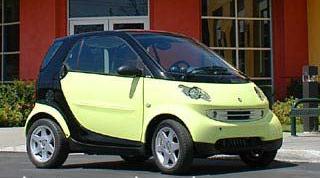Solving the Personal Urban Transportation Dilemma
© David Burton 2006

Solving the Personal Urban Transportation Dilemma |
 |
 |
 |
 |
 |
 |
 |
 |
 |
 |
 |
 |
 |
Last week while driving, I noticed this mini-sized car next to me. It was a very compact 2-seat vehicle with the name SmartCar printed on its door. I checked SmartCar out on the web and found the following information. Smart is short for Swatch Mercedes ART. Mercedes Benz initially launched the Smart car in Europe in 1998. After meeting all environmental and safety requirements, the Smart car was introduced into the United States in 1999. Initially, the Smart car was called the smart Micro Compact Car City Coupe. I found the following technical information on the Smart car: Number of cylinders: three; Number of gears: six; Length: 8’ 2.5”; Weight: 1600 lb; Horsepower: 50 hp; Gas Mileage: 45 to 71 mpg. One report from Vermont claims fuel economy of up to 100 mpg with very careful driving. By comparison, I drive a 4-door, 5-passenger compact car that is some 14.5' long, weighs in at 2530 lbs and averages around 32 mpg. My wife drives a 2-door, "4 passenger" vehicle that is 13.4' long, weighs 2900 lb and averages 23 mpg. SUV's are on the order of 15' to 16' long, weigh around 4,000 lb or more and typically get gas mileage around 21 mpg or less. Consider for a moment, gasoline priced at $2.50/gallon and annual driving of 12,000 mi with 1 or 2 people in the vehicle. The Smart car would use 200 gallons of fuel annually at a cost of $500. A vehicle that averages 25 mpg would consume 480 gallons of fuel annually at a cost of $1,200. Thus, one Smart car would save 280 gallons of fuel per year and $700 per year. The Smart car provides one solution to America’s urban driving dilemma. A major portion of commuting and urban driving involves only one or two people. Cars other than Smart car sized vehicles are grossly oversized and overweight for one or two passengers. As pointed out in More Profit with Less Carbon, Amory B. Lovins, Scientific American (Special Issue), September 2005, Pgs. 74-83, “Despite 119 years of refinement, the modern car remains astonishingly inefficient. Only 13 percent of its fuel energy even reaches the wheels. … And, because 95 percent of the accelerated mass is the car itself, less than 1 percent of the fuel ends up moving the driver. Yet the solution is obvious from the physics: greatly reduce the car’s weight, which causes three fourths of the energy losses at the wheels.” The Smart car addresses this problem. The Smart car is relatively light-weight, thus the outstanding fuel economy. In addition to conserving petroleum resources and reducing operating costs, the Smart car is also environmentally friendly since emission of pollutants is low. Additionally, the Smart car fits into very small parking spaces. What I propose is to encourage the purchase and use of the Smart car (or other similarly efficient second vehicles) for a large number of car owners. For those trips requiring a larger vehicle, keep the current car. But, for those trips where there is only the driver and perhaps one passenger, switch to a Smart car or equivalent. To make this economically realistic, our federal, state and local governments need to do the following. First, allow the transfer of license plates back and forth between cars. Only one at a time can be one road. Second, make insurance rates essentially the same as for a single car, again, since only one car at a time is on the road. Third, provide significant tax incentives for purchasing the Smart car or its equivalent. Fourth, make registration fees or other automobile fees, the same as for a single vehicle. Fifth, allow the Smart car to use HOV lanes. ---------------------------------------------------------------------------------------------References: http://www.smartcar-usa.com and http://www.smartcarofamerica.com |
| 21 February 2006 {Article 14; Undecided_04} |